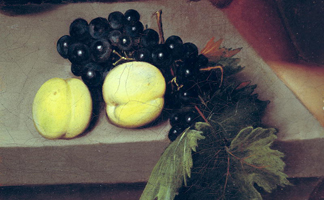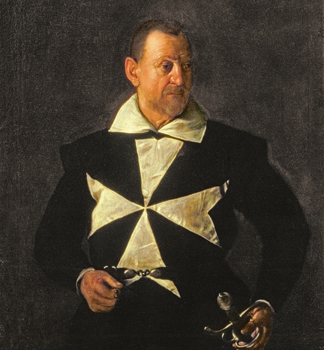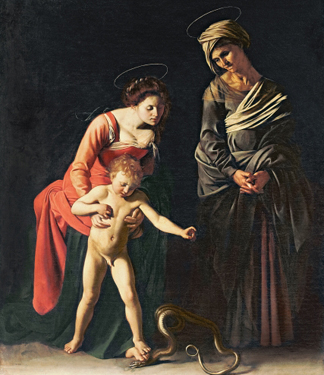Published 05/07/2010
| Michelangelo Merisi de Caravaggio was a revolutionary painter. His verbal and artistic rejection of the Renaissance ideal was dramatic, preferring instead to use nature as his guide, warts and all. Caravaggio broke with tradition a multitude of ways including painting directly from the model (instead of sketching first) and using street urchins and prostitutes as models. He certainly didn't earn any praise from the Church when he used a prostitute as the model for the Virgin Mary in many of his religious paintings. Caravaggio was also one of the first to paint true still-lifes, notably as part of larger paintings such as The Sick Bacchus (detail, right) and The Lute Player. |
Father of modern photography? A recent BBC news story describes researcher Roberta Lapucci's theory that Caravaggio’s techniques 200 years prior to the invention of the camera are the basis of modern photography. For example, Lapucci suggests Caravaggio used only artificial light to illuminate his subjects and also ‘fixed’ the image projected onto a canvas using light-sensitive compounds. Evidence that projections were used by Caravaggio can be seen in that he never made preliminary sketches. Lapucci also surmises that the image projected backwards on the canvas led to the high number of left-handed subjects in Caravaggio's paintings. |
|
| An angel, an outlaw and a knight Andrew Graham-Dixon, the author of Caravaggio: A Life Sacred and Profane says, “Caravaggio’s life is like his art, a series of lightning flashes in the darkest of nights.” Although named after an angel, Caravaggio did not live a peaceful life – he was a well known figure on the streets and he had more than a few brushes with the law. Within six years Caravaggio had already been brought to trial for violent crimes about a dozen times. In 1606, he killed Ranuccio Tommasoni in a duel after a disputed tennis game. Caravaggio fled Rome and turned up in Naples and Malta. His fortune seemed to be on the rise in Malta where he was knighted by the Knights of St. John, but trouble found him again and he was forced to escape from imprisonment and flee to Sicily. Still on the run, he managed to work steadily in Sicily and was finally absolved by Cardinal Gonzaga for Tommasoni’s murder. After having been absolved, Caravaggio tried to return to Rome only to make it as far as Tuscany where he died. |
A mysterious death The recent discovery of bones thought to be Caravaggio's combined with recent scholarship is shedding new light on how the artist lived and died. In a recent article in The Guardian, scientists have revealed they are fairly certain they’ve located Caravaggio’s bones. According to the article, the painter died at 38 from probable infection from wounds sustained in a brawl and sunstroke. In addition, it is possible that Caravaggio had lead poisoning likely from his years of working with paint, but that is not thought to have directly killed him. Goya and Van Gogh may have also suffered from an overexposure to lead, which can cause depression and personality changes. Other theories about Caravaggio's demise include being murdered by one of his many enemies, contracting malaria, or succumbing to a case of syphilis. |
|
| The master gets his day Caravaggio was not widely respected as an artist during his lifetime. Significantly, The Death of the Virgin and The Madonna of the Serpent (detail, left), both commissioned by the Church, were rejected upon receipt. The painter Nicolas Poussin famously said that Caravaggio "was sent into the world to destroy painting." Long after his death he remained a controversial character. Now, 400 years posthumous he is honored as one of the fathers of modern painting. Arguably, the works of Vermeer, La Tour, Rembrandt, and Delacroix would not have been the same without influences from Caravaggio. The American art historian Bernard Berenson said that 'With the exception of Michelangelo, no other Italian painter exercised so great an influence." This year, the 400th anniversary of his death, exhibitions all over the world are celebrating his life and work. An exhibition in Rome attracted almost 600,000 people. So many people were standing in line the last weekend of the exhibition that museum staff decided to keep the Scuderie del Quirinale open 24 hours a day until the closing. Click here to see works by Caravaggio in the Bridgeman archive. |







